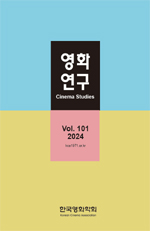- 영문명
- A Study on the Transculturation of Transnational Cinema and Korean Oral Culture
- 발행기관
- 한국영화학회
- 저자명
- 한미라(Mira Han)
- 간행물 정보
- 『영화연구』제101호, 165~199쪽, 전체 35쪽
- 주제분류
- 예술체육 > 예술일반
- 파일형태
- 발행일자
- 2024.09.23
7,000원
구매일시로부터 72시간 이내에 다운로드 가능합니다.
이 학술논문 정보는 (주)교보문고와 각 발행기관 사이에 저작물 이용 계약이 체결된 것으로, 교보문고를 통해 제공되고 있습니다.

국문 초록
전지구적인 것과 지역적인 것들이 서로 갈등하고 충돌하고 틈입하며 트랜스내셔널시네마를 통한 혼종의 공간을 만들어내고 있다. 본고의 목적은, 판소리로 대표되는 한166 국 구술문화의 특정성이 트랜스내셔널 시네마에 어떻게 기입, 중첩, 변용되고 있는가그 문화번역의 순간들을 규명하는 데 있다.
이와 관련하여, 본고는 트랜스내셔널 시네마에 있어 보이스오버 내레이션과 플래시백 구조에 주목하고 있다. 먼저 문화횡단의 콘택트 존으로서 <워리어스 웨이>(2010, 이승무)에서는 판소리의 사설이 비인칭 화자(noncharacter narrator)의 보이스오버 내레이션과 이를 다시 제시하는 자막으로, 그리고 ‘장면의 극대화’가 플래시백과 슬로우 모션 등으로 번역되고 있음을 주장하였고, 이 과정에서 장르 혼종이라는미끄러지고 탈구하는 순간을 발견하였다. 둘째, <퍼햅스 러브>(2005, 진가신)에서 구술문화의 부분의 독자성 및 삽화적 서사구조가 극중인물을 통한 다중초점의 서술과지엔(금성무)의 기억에 의한 플래시백 구조로 번역되고 있음을, 그리고 이를 통해 멜로드라마 장르를 기입하는 불확정적이고 미결정적인 순간을 만들어내고 있음을 주장하였다. 마지막으로 <설국열차>(2013, 봉준호)에서 아비규환의 스펙터클을 커티스의일인칭 독백이라는 청각적 스펙터클로 갈음하고 있는 바, 이를 통해 정서적 과잉의멜로드라마로 선회하고 있음을 주장하였다.
이러한 논의를 ‘호미 바바의 혼종성’과 ‘마이클 크로닌의 번역’ 개념에 기대어 전개하였다. 마이클 크로닌의 ‘가변적 이동체(mutable mobile)’라는 번역 개념은, 일부는 첨가되고 일부는 떨어져 나가면서 모든 것이 정확히 같은 장소에서 안정적인 형태로 작동하지는 않는, 다시 말해 불확정적이고 유동적인 문화번역을 말한다. 이 입장에서, 번역은 원본에 미달하는 “실패, 기형, 빈약한 유사성과 그 손실”이 아니라 모순과갈등이 상존하는 “역동적이고 가변적인 사회적 활동들과 사회적 관계들”의 교섭으로, “잠재적으로 변형 가능한 실천”으로 위치 지을 수 있다.
이처럼 문화번역을 서로 간섭하고 변형시키는 역동적 과정이라 할 때, 호미 바바의혼종성을 떠올릴 수 있다. 바바는 식민주의자와 피식민지인의 관계를 단순히 지배와억압의 이분법이 아닌 서로 갈등하고 충돌하고 교섭하는 혼종성과 번역의 공간으로본다. 즉 식민공간은 일방적인 식민주의자의 권위가 공고해지는 정태적 공간이 아니라 지배와 저항의 대립이 끊임없이 미끄러지고 갈라지고 탈구하는 역동적 공간, 불투명하고 불확정적이고 불안정한 혼종성과 양가성의 공간이다.
이러한 방법론을 통해 본고는 한국의 구술문화와 트랜스내셔널 시네마를 통한 번역의 실천이 전지구적인 것과 지역적인 것의 틈새를 열어주는 통로이자 매개 공간으로 작용하고 있음을 주장하였다. 번역가로서의 트랜스내셔널 시네마는 다른 지역과문화를 서로 동떨어지고 무관한 것으로 분리하는 것이 아니라 “우리의 존재와 정체성을 뒤흔드는 ‘사이in-betweenness’와 ‘틈새interstice’와 ‘너머beyond’에 대한 새로운 인식을 가능케 하는”, 즉 우리의 정체성을 (탈)구축하며 새로운 시작을 여는 공간으로, 이들 영화가 그 과정 중에 위치하고 있다.
영문 초록
In transnational cinema, the global and the local are in conflict, collision, and interpenetration with each other, creating a space of hybridity. In this paper, I aim to identify the ways in which Korean oral culture, represented by pansori, is transcribed, superimposed, and transformed in transnational cinema.
To this end, I focus on voice-over narration and flashbacks in transnational films. First, in Warrior’s Way (Lee Seung-moo, 2010), the song stories of pansori are presented through voice-over narration by a noncharacter narrator and subtitles that retell them, and the “maximization of the scene” is expressed through flashbacks and slow motion. Through these styles and forms, the film functions as a space where different cultures meet, creating slippery and dislocating moments of genre hybridity. Second, Perhaps Love (Peter Chan, 2005) embraces the autonomy of parts and narrative structure of oral culture through its multifocal narrative and flashbacks, expressing indeterminate and undecided moments of melodrama. Finally, I claim that the chaotic spectacle in Snowpiercer (Bong Joon-ho, 2013) is replaced by the aural spectacle of Curtis’s first-person monologue, which turns the action into a melodrama of emotional excess.
As a methodology for this analysis, I apply Homi Bhabha’s concept of hybridity and Michael Cronin’s proposed translation. Cronin describes “mutable mobile” as a cultural translation that is uncertain and fluid, where some things are added and some things are taken away, so that nothing ends up working in exactly the same place. From this perspective, translation is not a “failure, deformity, poor resemblance, and its loss” to the original, but rather a negotiation of “dynamic and variable social activities and social relations” with their contradictions and conflicts, which in turn can become “potentially transformative practices.”
This view of cultural translation as a dynamic process of mutual interference and transformation is similar to Homi Bhabha’s hybridity. Bhabha argues the relationship between the colonizer and the colonized is not simply a dichotomy of domination and oppression, but a space of hybridity and translation in which the two are in conflict, collision, and negotiation. In other words, colonial space is not a static space where the authority of the colonizer is entrenched, but a space of instability, hybridity, and ambivalence where power relations are fractured and dislocated through the confrontation of domination and resistance.
Based on this discussion, I argue that the practice of cultural translation through Korean oral culture and transnational cinema functions as a medium through which the global and the local meet and interact. Transnational cinema, as a translator, does not separate different regions and cultures as disparate and unrelated, but rather allows for an awareness of “the ‘in-betweenness’ and the ‘interstices’ and the ‘beyond’ that shake our existence and identity.” That is, transnational cinema is a space and a process that (de)constructs our identity and opens up new beginnings.
목차
1. 들어가면서
2. 문화번역의 정치학
3. 한국의 구술문화, 판소리와 무성영화의 변사 연행
4. 트랜스내셔널 시네마의 보이스오버 내레이션과 플래시백
5. 나오면서
키워드
해당간행물 수록 논문
참고문헌
관련논문
예술체육 > 예술일반분야 BEST
- 생성형 AI 도구와 디자이너의 협업 프로세스 개발 - 이미지를 통한 아이디어 확산에서 고해상도 렌더링까지
- 영화 [올드보이]와 소포클레스 「오이디푸스 왕」의 상동성 연구
- ‘일과 삶의 균형(Work-Life Balance)’ 척도 개발을 위한 연구
예술체육 > 예술일반분야 NEW
- Z세대 생활체육 동호인들의 SNS 중독 경향성과 불안정 성인애착이 완벽주의적 자기제시 및 우울에 미치는 영향
- 즐거움과 몰입을 통한 수익성 기대가 NFT 구매 의도에 미치는 매개효과 분석: UTAUT2와 합리적 무관심(RI)을 중심으로
- 생태체험이 청소년의 자연친밀감, 환경태도, 환경행동의도에 미치는 영향
최근 이용한 논문
교보eBook 첫 방문을 환영 합니다!

신규가입 혜택 지급이 완료 되었습니다.
바로 사용 가능한 교보e캐시 1,000원 (유효기간 7일)
지금 바로 교보eBook의 다양한 콘텐츠를 이용해 보세요!



